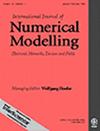An Affine Linear Solution of the Nonlinear Inverse Power Flow Problem in Resistive Networks
IF 1.6
4区 工程技术
Q3 ENGINEERING, ELECTRICAL & ELECTRONIC
International Journal of Numerical Modelling-Electronic Networks Devices and Fields
Pub Date : 2025-03-27
DOI:10.1002/jnm.70026
引用次数: 0
Abstract
In the analysis of linear electrical networks, an inverse problem can be inferring all edge impedances only from known external voltage sources and measured resulting edge currents. Given all external edge voltages and all resulting edge currents , we present a new calculation method for the edge resistances , with the assumption that the reactance is everywhere zero (e.g., a resistive network). Our considerations are based on affine subspaces and their intersection. We show, that in case of having a sequence of measurements , we can calculate uniquely in every such network. For a sufficiently large but still small cuboid grid, we can reduce the number of needed measurements to 2.

电阻网络中非线性逆潮流问题的仿射线性解
在线性电网的分析中,一个逆问题是只能从已知的外部电压源和测量得到的边缘电流推断出所有的边缘阻抗。给定所有外部边缘电压(下$$ {\boldsymbol{u}}_{\mathrm{ext}} $$)和所有产生的边缘电流($$ \boldsymbol{i} $$),我们提出了一种新的边缘电阻R $$ \boldsymbol{R} $$的计算方法,假设电抗处处为零(例如,电阻网络)。我们的考虑是基于仿射子空间和它们的交集。我们展示,当有1≥3次$$ l\ge 3 $$测量序列时1、…下一个我会$$ \left({\boldsymbol{u}}_{{\operatorname{ext}}_1},{\boldsymbol{i}}_1\right),\dots, \left({\boldsymbol{u}}_{{\operatorname{ext}}_l},{\boldsymbol{i}}_l\right) $$,我们可以在每个这样的网络中唯一地计算R $$ \boldsymbol{R} $$。对于一个足够大但仍然很小的长方体网格,我们可以将所需的测量次数减少到2。
本文章由计算机程序翻译,如有差异,请以英文原文为准。
求助全文
约1分钟内获得全文
求助全文
来源期刊
CiteScore
4.60
自引率
6.20%
发文量
101
审稿时长
>12 weeks
期刊介绍:
Prediction through modelling forms the basis of engineering design. The computational power at the fingertips of the professional engineer is increasing enormously and techniques for computer simulation are changing rapidly. Engineers need models which relate to their design area and which are adaptable to new design concepts. They also need efficient and friendly ways of presenting, viewing and transmitting the data associated with their models.
The International Journal of Numerical Modelling: Electronic Networks, Devices and Fields provides a communication vehicle for numerical modelling methods and data preparation methods associated with electrical and electronic circuits and fields. It concentrates on numerical modelling rather than abstract numerical mathematics.
Contributions on numerical modelling will cover the entire subject of electrical and electronic engineering. They will range from electrical distribution networks to integrated circuits on VLSI design, and from static electric and magnetic fields through microwaves to optical design. They will also include the use of electrical networks as a modelling medium.

 求助内容:
求助内容: 应助结果提醒方式:
应助结果提醒方式:


